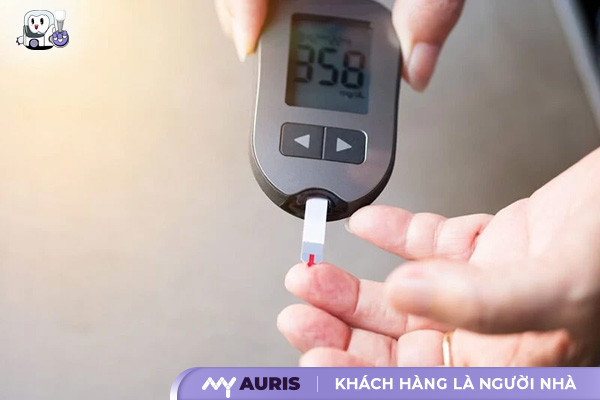Elderly people often experience a decline in their immune system and face many chronic diseases such as hypertension, cardiovascular disease, and especially diabetes. The question of whether people with diabetes can get implants is of great concern to many, as this condition is considered a factor that needs careful consideration before performing implant placement. So, is this case an absolute contraindication? To get a clearer understanding of whether people with diabetes can get implants and what conditions need to be met to ensure safety, continue reading the information shared by dental experts below.
What is diabetes?
Diabetes, also known as diabetes mellitus, is a chronic metabolic disorder that occurs when the body’s insulin secretion decreases or peripheral insulin resistance changes, leading to prolonged high blood sugar. When blood glucose levels are high, patients often experience early symptoms such as increased thirst, frequent urination, and blurred vision.
If not diagnosed and treated promptly, diabetes can progress to severe late complications. These complications include vascular disease, peripheral neuropathy, kidney disease, and make patients more susceptible to infections. Quantifying plasma glucose is a common method to determine the disease status.
Current treatment regimens for the disease focus on lifestyle changes and medication. Specifically, doctors often recommend an appropriate diet, regular exercise combined with drugs that reduce blood glucose levels such as insulin, oral hypoglycemic agents, or non-insulin injectable drugs.
Complications can be delayed or prevented if patients adequately control blood sugar and adhere to the treatment regimen. Notably, cardiovascular disease remains the leading cause of death in diabetic patients, so early detection and treatment are extremely important.

Can diabetics get dental implants?
Dental implant placement in diabetic patients is a topic of widespread interest, as this group of patients with chronic conditions can affect healing ability and have a higher risk of infection. However, in reality, people with diabetes can still get dental implants if they meet the necessary medical factors.
Implanting teeth into the jawbone is a safe and effective solution to restore missing teeth. This process uses an implant root, which is drilled and attached directly to the jawbone, creating a solid foundation for durable new teeth. However, during the procedure, the doctor needs to incise the gum and drill the bone, causing more or less bleeding depending on the individual’s constitution.
For healthy individuals, dental implant placement usually does not cause adverse effects, but for diabetic patients, this becomes a major concern. The reason is that the body is more susceptible to infection, wounds heal slower, or the risk of implant rejection is higher than normal. In addition, common oral diseases in diabetics also make dental implant placement more difficult.
However, according to the professional experience of specialists, people with diabetes can still get dental implants if they meet the following requirements:
- General oral health examination, combined with X-ray or CT Conebeam scans to assess bone density and condition at the implant site.
- Blood tests for biochemical parameters to assess the diabetic condition at the time of implant placement.
- If the disease is well controlled and stable, the probability of being approved for dental implant placement is up to 90%.
Safe blood sugar levels for dental implant placement include:
- Fasting blood sugar: 90–130 mg/dl
- Blood sugar 2 hours after eating: below 180 mg/dl
- Blood sugar before sleep: approximately 110 mg/dl
When blood tests meet the criteria, diabetic patients undergoing dental implant placement will achieve results similar to healthy individuals if they adhere to the doctor’s instructions. This is not an absolutely contraindicated patient group but requires close monitoring by the medical team.

What tests do diabetics need before dental implant placement?
Due to the specific nature of diabetes, patients are at a higher risk of implant failure if their health is not thoroughly assessed. Before getting implants, a series of important tests must be performed to ensure that the patient is eligible for safe and effective surgery.
Blood tests for comprehensive health assessment
This is the first and mandatory step for both healthy individuals and diabetics. The doctor will check indicators such as:
- Red blood cells, white blood cells, and platelets – reflecting immunity and blood clotting ability.
- Blood sugar levels, blood flow rate, blood clotting – especially important to ensure the implant procedure does not cause complications.
If the indicators are within the safe range, the patient is considered eligible for implant placement.
Blood sugar levels
- Below 70 mg/dL: Dextrose solution supplementation is needed.
- 70–250 mg/dL: Normal intravenous fluid can be administered to maintain stable veins.
- 250–300 mg/dL: Insulin injection is required for control.
HbA1c levels
HbA1c (Hemoglobin A1c) reflects the average blood sugar level over 2–3 months. A low level indicates that the patient has well-controlled diabetes, thereby supporting the healing process after implant placement.
This index also helps doctors assess the risk of diabetes-related complications before surgery.
CRP (C-reactive protein) levels
High CRP indicates inflammation in the body, which can affect the wound healing process. Therefore, checking CRP helps prevent risks after surgery and ensures good wound recovery.
Check for co-existing chronic diseases
Elderly people with diabetes often also have high blood pressure. In this case, the doctor needs to:
- Review the medical history and continuously monitor blood pressure throughout the implant procedure.
- Instruct the patient to take blood pressure medication on time and at the correct dosage, helping to prevent sudden drops or rises in blood pressure.
- Create a safe, careful, and attentive treatment environment, helping the patient feel comfortable before surgery.
Check for oral diseases
Before implant placement, all oral diseases such as cavities, pulpitis, periodontitis need to be completely treated.
This ensures high durability of the dental implant and helps patients maintain long-term oral health.
Assess jawbone stability and quality
The implant post needs to be placed into the jawbone, so a thorough check is required for:
- Bone quality and quantity, especially jawbone thickness.
- The HU (Hounsfield Unit) index needs to be between 350HU–1250HU.
If the bone is too porous (low HU), the implant post is prone to wobbling.
If the bone is too dense (high HU), blood vessels are scarce, causing slow wound healing.
Full-arch CT scans using a ConeBeam CT machine will help the doctor determine:
- If the jawbone, maxillary sinus, and missing tooth position are suitable for implant placement.
- If the bone wall is too thin or bone resorption has occurred due to long-term tooth loss, bone grafting may be needed before implant placement.
Important notes for dental implant placement in diabetics
Dental implant placement in diabetics is entirely feasible if blood sugar levels are well controlled and jawbone conditions are ideal. However, to avoid dangerous complications, patients need to pay special attention to pre-implant and post-implant care strictly following medical instructions.

Before implant placement
One of the crucial factors determining implant success is choosing a reputable dental clinic. Prioritize clinics with a highly skilled and experienced team of doctors who have treated complex cases, and use modern equipment. This ensures a safe and precise implant procedure for diabetic patients.
Additionally, patients need to strictly follow the doctor’s instructions. Rest, relax your body, and prepare mentally for the implant procedure. During the initial consultation, remember to share any other medical symptoms, history of allergic reactions, or current medications so the doctor can plan an appropriate treatment.

After implant placement
– Avoid strong jaw movements initially to allow the wound to heal quickly. Brush your teeth with a small-headed, soft-bristled toothbrush twice a day and do not brush too vigorously to limit gum tissue damage. Combine with dental floss and specialized mouthwash for thorough oral cleaning.
– Prioritize soft, smooth, pureed foods like porridge, soup, smoothies, and juices. In the first week after implant placement, avoid beef, water spinach, and sticky rice – these foods must be absolutely avoided due to their potential to cause the open wound to fester.
– If swelling or pain occurs, you can apply ice packs and take pain relievers as prescribed by the doctor. Absolutely do not self-medicate with antibiotics without instruction.
– Drink at least 2 liters of water daily, supplement with fruits and green vegetables to balance nutrients and support the healing process.
– Absolutely do not smoke, drink alcohol, and limit fatty foods, oily foods, and starches to protect overall health and the implant.
– Finally, remember to visit the dentist every 6 months for comprehensive dental check-ups and care, helping the implant stabilize and last long-term.





